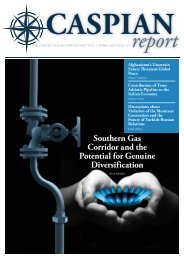Hazar Raporu - Issue 02 - Winter 2012
Create successful ePaper yourself
Turn your PDF publications into a flip-book with our unique Google optimized e-Paper software.
to take a free bus tour of Tbilisi en route.<br />
He will continue his trip on an express<br />
ferry to Turkmenbashy, from where<br />
another high-speed train will take him all<br />
the way to Urumqi in China. The entire<br />
territory of Central Eurasia will be covered<br />
with a great infrastructure of highways,<br />
railways, airports, and logistics centers that<br />
will handle goods and passengers moving<br />
between Europe and Asia.<br />
For many countries in Central Eurasia,<br />
however, envisioning such future is a<br />
complex matter. Political, economic, and<br />
social crises caused by the sudden collapse<br />
of the Soviet Union have dominated the<br />
relatively short history of independence<br />
enjoyed by these states. In 2011, they<br />
celebrated only the twentieth anniversary<br />
of the end of Soviet rule. Memories of<br />
wars, unresolved conflicts, economic<br />
hardships, and coups still haunt the<br />
generation old enough to remember the<br />
days of communist control. Fortunately,<br />
the most difficult times have been left<br />
behind, though a few crucial challenges<br />
persist. The countries of Central Eurasia<br />
are now at the stage of development where<br />
they must complete their political and<br />
economic transitions and choose a path<br />
that would lead them into the ranks of<br />
prosperous developed nations.<br />
The Process of Becoming: Central<br />
Eurasia Twenty Years Later<br />
In the 1990s, many people in the resourcerich<br />
states of Central Eurasia believed that<br />
their respective countries would soon<br />
become the “Kuwaits” and “Switzerlands”<br />
of the twenty-first century. The abundance<br />
of natural resources made this notion so<br />
alluring and so palpable that few really<br />
thought about the process by which this<br />
goal would be realized, if it were to be<br />
realized at all. Becoming another Kuwait<br />
or Switzerland would have required<br />
different development strategies, with a<br />
strategic vision supported by the presence<br />
of other essential components, such as a<br />
business friendly environment, political<br />
and economic capabilities, the effective<br />
management of revenues from the sale<br />
of natural resource and an advantageous<br />
location.<br />
In the past twenty years, the regional<br />
countries, especially the resource-rich<br />
ones, have achieved a great deal. In 2009,<br />
the GDPs of Azerbaijan, Kazakhstan,<br />
Uzbekistan, and Turkmenistan exceeded<br />
$43 billion, $115 billion, $32 billion,<br />
and $19 billion, respectively. On the<br />
other hand, the combined GDP of the<br />
remaining four, more poorly endowed,<br />
states—Armenia, Georgia, Kyrgyzstan,<br />
and Tajikistan—was less than $30<br />
billion. Azerbaijan and Kazakhstan<br />
have attracted billions of dollars in<br />
FDI and have completed key energy<br />
infrastructure projects that guarantee<br />
their future development. A latecomer,<br />
Turkmenistan, has started opening its<br />
doors to investors only recently, with<br />
the great expectations still to be met.<br />
The most populous state in the region,<br />
Uzbekistan, has chosen a gradual domestic<br />
106 104










